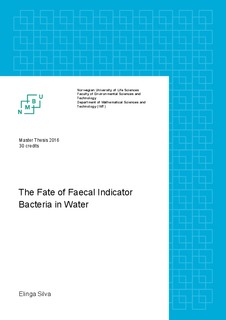| dc.contributor.author | Silva, Elinga | |
| dc.date.accessioned | 2016-04-04T08:13:22Z | |
| dc.date.available | 2016-04-04T08:13:22Z | |
| dc.date.issued | 2016-04-04 | |
| dc.identifier.uri | http://hdl.handle.net/11250/2383667 | |
| dc.description.abstract | Background:
The research experiments provide data on decay rate of faecal indicator bacteria in water. Such data are useful input to transport models to estimate the concentrations of faecal indicator bacteria at beaches in the days after sewage discharges. Sample data come from laboratory experiments where sewage was added to seawater at different environmental conditions. This research is a part of the project “Impact of changing weather patterns on bathing water and seafood quality from the Inner Oslofjord” financed by Regionale Forskningsfond Hovedstaden.
Purpose: This study is aimed to decide what was the best input to the models, to describe the decay when we put sewage into the Oslofjord when it is raining and how long time after this events can the beaches be used. Then main finding was to know how quickly they died by doing experiments and researching the literature.
Methods:
Hipsey provided a process-based model of microbial pollution used on fresh and seawaters. (Hipsey et al. 2008). According to the international requirements and standards for water quality, it is necessary to apply the appropriate indicators or parameters to a specific location of water. The raw wastewater from Drøbak waste treatment plant used as a typical sewage. We selected surface seawater with high biological activity and deep seawater (with probably lower biological activity) because the discharges from large CSOs are often at deep water.
Aim of preliminary experiments: Learn the methods for enumeration of FIB. The Collilert-18 rapid method enumerated Escherichia coli (E. coli) by using IDEXX tables (MPN/100mL). Positive colonies interpreted as (CFU/100mL) counted Intestinal Enterococci (I. enterococci) using membrane filtration method. The Main experiment aims in enumerate the faecal indicators bacteria (FIB) to evaluate the possibility of contaminants in surface and deep seawater. New suggestions were made to use faster and modern methods to get results at faster pace. The selected methods were Collilert-18 for E. coli and Enterolert-E for I. enterococci.
Results and discussion:
The results showed that 1-3 log reduction in fecal indicator bacteria from the day of collection to the 3rd to 5th day of the laboratory experiment. The deep seawater curve in Escherichia coli, which was stored at 220C, revealed a much better fit to the first order linear model equation. While the Intestinal enterococci, at 220C deep seawater was the less fitted curve. The results also indicated that the decay rate (kt) of the deep seawater and surface seawater are not significantly different when stored at same temperature, but the same types of seawater (deep or surface) showed a slightly difference when kept at different temperature. It indicates that the temperature is an importance factor in decay of fecal indicator bacteria. The graphs showed that the decay of FIB decreased after three days with similar behaviors as in the preliminary experiments but using deep and surface water at 4 and 22 degree Celsius (0C). In general, the bacteria decay with temperature of 220C was much faster than in 40C, which shows the influence of temperature in fate of FIB. The results showed that E. coli in seawater declined faster than those in freshwater. And the same occurs with values for I. enterococci. Those decay rates show a difference for values between the seawater and freshwater just in 3 to 5 days at room temperature and this correlates with studies where FIB in seawater.
Conclusion:
Measurements of indicator bacteria E. coli and I. enterococci in water using Colilert-18, Enterolert-E and membrane Filtration methods to predict the decay rate of faecal indicator bacteria in water that was polluted with combined sewage water are acceptable and the linearity of the curves for the decay rate were a good fit with model equation. FIB decay rate results for only 1-2 days to reduce to 1 log10 at warmer temperature (E. coli) and more and this was considered useful to show the fate of the bacteria and more that 100 days in cold temperature (I. enterococci). Regardless if whether or not we could have used more days to test the FIB. However, the faecal indicator bacteria may behave different at cold and harmer temperatures and also at different levels of water. | nb_NO |
| dc.language.iso | eng | nb_NO |
| dc.publisher | Norwegian University of Life Sciences, Ås | |
| dc.rights | Navngivelse-Ikkekommersiell-DelPåSammeVilkår 3.0 Norge | * |
| dc.rights.uri | http://creativecommons.org/licenses/by-nc-sa/3.0/no/ | * |
| dc.subject | Fate | nb_NO |
| dc.subject | Faecal indicator bacteria | nb_NO |
| dc.title | The fate of faecal indicator bacteria in water | nb_NO |
| dc.type | Master thesis | nb_NO |
| dc.subject.nsi | VDP::Mathematics and natural science: 400::Chemistry: 440::Environmental chemistry, natural environmental chemistry: 446 | nb_NO |
| dc.source.pagenumber | 110 | nb_NO |
| dc.description.localcode | M-VM | nb_NO |

